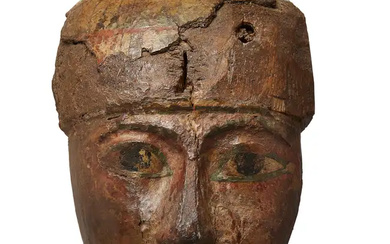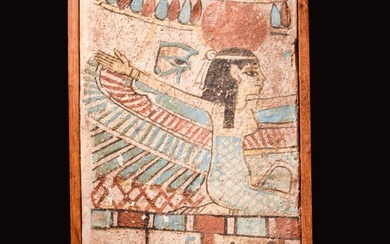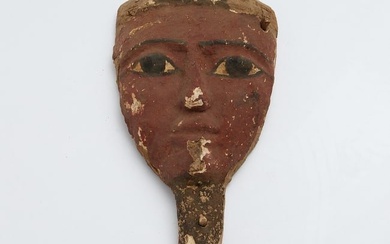Egyptian Wood & Painted Gesso Mummy Mask
Ancient Egypt, Third Intermediate Period, 21st to 25th Dynasty, ca. 1069 to 664 BCE. A hand-carved wooden mummy mask of a dignified form with stylized features that allude to what the deceased would have looked like while still living. The slender countenance features puffy lips, tapered cheeks, a narrow nose with delineated nostrils, almond-shaped eyes with elongated corners, and thick brows, all beneath a lobed hat. The mask is first covered in a layer of white gesso and painted with vibrant hues including crimson on the face, olive green with concentric black rings on the hat, and a black-and-tan motif on the false beard. The verso has three original dowel holes remaining. Size: 4.2" W x 8.5" H (10.7 cm x 21.6 cm); 12.25" H (31.1 cm) on included custom stand.
Ancient Egyptians believed it was of the utmost importance to preserve a body of the deceased, because the soul needed a place to reside after the death. Preservation of the body was done via mummification - a process involving the removal of internal organs that were placed in canopic jars, wrapping body in linen, and then embalming. Death masks like this example were created so that the soul could recognize the body and return to it. For this reason, death masks were made in the likeness of the deceased. Artisans used different materials. Earlier masks were carved from wood. Later, cartonnage, a material made from papyrus or linen and soaked in plaster which was then applied to a wooden mold, was used. Royal death masks, perhaps the most famous being that of Tutankhamen, were made from precious metals. All death masks were intended to resemble the deceased subject; however, eyes were always slightly enlarged and lips presented in a subtle smile as we see in this example.
Provenance: private J.H. collection, Beaverton, Oregon, USA, acquired in 2001; ex-Edgar L. Owen, Ltd., Lake Hopatcong, New Jersey, USA
All items legal to buy/sell under U.S. Statute covering cultural patrimony Code 2600, CHAPTER 14, and are guaranteed to be as described or your money back.
A Certificate of Authenticity will accompany all winning bids.
We ship worldwide to most countries and handle all shipping in-house for your convenience.
#151250
Condition Report: Losses to back of false beard as well as areas of painted gesso as shown. Nicks and abrasions to beard, face, hat, peripheries, and verso, with light fading to original pigmentation, and minor encrustations. Light earthen deposits throughout, and great traces of original painted gesso across face.
View it on
Estimate
Time, Location
Auction House
Ancient Egypt, Third Intermediate Period, 21st to 25th Dynasty, ca. 1069 to 664 BCE. A hand-carved wooden mummy mask of a dignified form with stylized features that allude to what the deceased would have looked like while still living. The slender countenance features puffy lips, tapered cheeks, a narrow nose with delineated nostrils, almond-shaped eyes with elongated corners, and thick brows, all beneath a lobed hat. The mask is first covered in a layer of white gesso and painted with vibrant hues including crimson on the face, olive green with concentric black rings on the hat, and a black-and-tan motif on the false beard. The verso has three original dowel holes remaining. Size: 4.2" W x 8.5" H (10.7 cm x 21.6 cm); 12.25" H (31.1 cm) on included custom stand.
Ancient Egyptians believed it was of the utmost importance to preserve a body of the deceased, because the soul needed a place to reside after the death. Preservation of the body was done via mummification - a process involving the removal of internal organs that were placed in canopic jars, wrapping body in linen, and then embalming. Death masks like this example were created so that the soul could recognize the body and return to it. For this reason, death masks were made in the likeness of the deceased. Artisans used different materials. Earlier masks were carved from wood. Later, cartonnage, a material made from papyrus or linen and soaked in plaster which was then applied to a wooden mold, was used. Royal death masks, perhaps the most famous being that of Tutankhamen, were made from precious metals. All death masks were intended to resemble the deceased subject; however, eyes were always slightly enlarged and lips presented in a subtle smile as we see in this example.
Provenance: private J.H. collection, Beaverton, Oregon, USA, acquired in 2001; ex-Edgar L. Owen, Ltd., Lake Hopatcong, New Jersey, USA
All items legal to buy/sell under U.S. Statute covering cultural patrimony Code 2600, CHAPTER 14, and are guaranteed to be as described or your money back.
A Certificate of Authenticity will accompany all winning bids.
We ship worldwide to most countries and handle all shipping in-house for your convenience.
#151250
Condition Report: Losses to back of false beard as well as areas of painted gesso as shown. Nicks and abrasions to beard, face, hat, peripheries, and verso, with light fading to original pigmentation, and minor encrustations. Light earthen deposits throughout, and great traces of original painted gesso across face.







